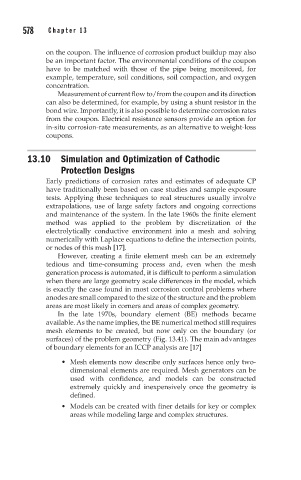Page 615 - Corrosion Engineering Principles and Practice
P. 615
578 C h a p t e r 1 3 C a t h o d i c P r o t e c t i o n 579
on the coupon. The influence of corrosion product buildup may also
be an important factor. The environmental conditions of the coupon
have to be matched with those of the pipe being monitored, for
example, temperature, soil conditions, soil compaction, and oxygen
concentration.
Measurement of current flow to/from the coupon and its direction
can also be determined, for example, by using a shunt resistor in the
bond wire. Importantly, it is also possible to determine corrosion rates
from the coupon. Electrical resistance sensors provide an option for
in-situ corrosion-rate measurements, as an alternative to weight-loss
coupons.
13.10 Simulation and Optimization of Cathodic
Protection Designs
Early predictions of corrosion rates and estimates of adequate CP
have traditionally been based on case studies and sample exposure
tests. Applying these techniques to real structures usually involve
extrapolations, use of large safety factors and ongoing corrections
and maintenance of the system. In the late 1960s the finite element
method was applied to the problem by discretization of the
electrolytically conductive environment into a mesh and solving
numerically with Laplace equations to define the intersection points,
or nodes of this mesh [17].
However, creating a finite element mesh can be an extremely
tedious and time-consuming process and, even when the mesh
generation process is automated, it is difficult to perform a simulation
when there are large geometry scale differences in the model, which
is exactly the case found in most corrosion control problems where
anodes are small compared to the size of the structure and the problem
areas are most likely in corners and areas of complex geometry.
In the late 1970s, boundary element (BE) methods became
available. As the name implies, the BE numerical method still requires
mesh elements to be created, but now only on the boundary (or
surfaces) of the problem geometry (Fig. 13.41). The main advantages
of boundary elements for an ICCP analysis are [17]
• Mesh elements now describe only surfaces hence only two-
dimensional elements are required. Mesh generators can be
used with confidence, and models can be constructed
extremely quickly and inexpensively once the geometry is
defined.
• Models can be created with finer details for key or complex
areas while modeling large and complex structures.

